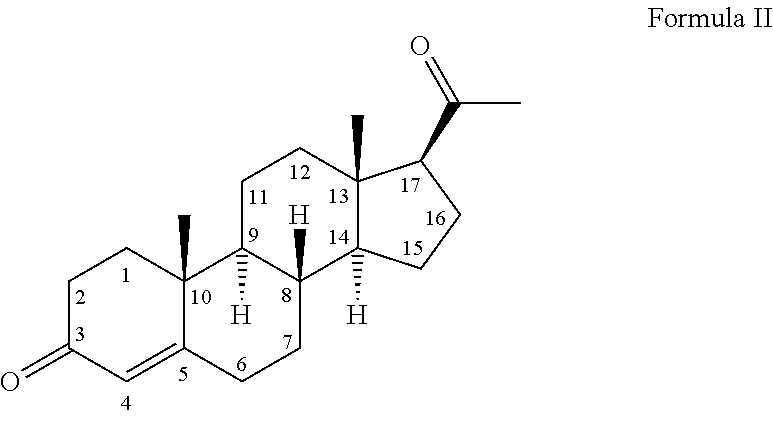Low-oil pharmaceutical emulsion compositions comprising progestogen
a technology of progestogen and pharmaceutical composition, which is applied in the direction of drug compositions, oil/fat/waxes non-active ingredients, nervous disorders, etc., can solve the problems of reducing mortality of tbi patients, no approved medications proven to improve mortality or outcomes, and tbi is a major cause of death and disability worldwide, so as to increase the solubility of progesterone, improve the effect of progesterone solubility and moderate elevation of histamin
- Summary
- Abstract
- Description
- Claims
- Application Information
AI Technical Summary
Benefits of technology
Problems solved by technology
Method used
Image
Examples
specific example
[0153]In one specific embodiment, the composition of the present invention comprises 0.15-0.25% wt / vol progesterone; 5.0-7.0% wt / vol oil; 1.0-1.4% wt / vol egg lecithin; 80-98.9% wt / vol water; and has a pH of 6.0-9.0. Compositions according to this specific embodiment represent a compromise between delivery of a desirable amount of progestogen per unit volume liquid, delivery of a desirable amount of progestogen per unit oil, physical stability and safety of administration of the emulsion.
Properties of the Emulsion
[0154]Compositions according to the present invention typically are milky white in appearance, and present as visually homogenous emulsions.
Emulsion Droplet Particle Size Distribution
PFAT5 Value
[0155]The United States Pharmacopeia (USP) sets the limit for globule size distribution in lipid injectable emulsions (USP 729—Pharm. Forum. 2005; 3:1448-1453). The limit for fat globules of diameter>5 μm in injectable emulsions, expressed as volume-weighted percentage fat>5 μm is not...
example 1
Highly Desirable Embodiment
[0234]The formulation of Example 1 is a 6% oil emulsion composition, comprising 0.2% progesterone and 1.2% egg lecithin. The phospholipid is present in an amount of 17% of the oil (wt / wt), and the progesterone to oil ratio is 1:30 (wt / wt).
TABLE IMaterialQuantityWater forAd 400LInjectionEgg lecithin PL904.77kgGlycerol9.98kgOleic acid0.12kgNaOH 1M470mlSoy bean oil23.97kgProgesterone0.81kg
[0235]The emulsion of Table I was manufactured as follows. Components, mixtures and the finished emulsion were kept under nitrogen gas, and at a temperature of 55-60° C., unless otherwise indicated.
[0236]180 L of water for injection (w.f.i.) was added to a first vessel, warmed to 58° C., whilst mixing at 50 Hz and degassed with nitrogen until a residual oxygen concentration of ≦0.1 mg / L was obtained. 9.98 kg glycerol (anhydrous Glycerol, Axelis, Austria) was added to the water and mixed for 5 minutes at 50 Hz. 23.97 kg of soybean oil (Fresenius Kabi, Sweden) was added to a s...
example 4
Effect of Phospholipid
[0254]The following example demonstrates the effect of varying the phospholipid content of emulsion compositions on the properties of the emulsions. The 6% oil emulsions of Table IV were prepared by the method outlined below. The emulsions contained 0.2% progesterone, and either 1.8%, 1.5%, 0.9%, or 0.6% lecithin.
TABLE IVEXAMPLE 4ABCDWater forAd 10LAd 10LAd 10LAd 10LInjectionEgg lecithin180g150g90g60gGlycerol250g250g250g250gSodium oleate3g3g3g3gSoy bean oil600g600g600g600gProgesterone20g20g20g20gNaOH (1M)9ml9ml9ml9mlNaOH (1M)3mlAd pH 8.0-8.8
[0255]The emulsions of example 4A-D were prepared by the following method. 600 g soybean oil (Fresenius Kabi, Sweden) was added to a vessel and warmed to 58° C. The oil was kept under an atmosphere of nitrogen gas whilst 20 g progesterone (micronized progesterone by Proquina, Mexico) was added to the soybean oil and dissolved by mixing with a magnetic stirrer. WFI was placed in a second vessel and heated to 58° C. 250 g glyc...
PUM
| Property | Measurement | Unit |
|---|---|---|
| osmolality | aaaaa | aaaaa |
| volume-based mean diameter | aaaaa | aaaaa |
| volume-based mean diameter | aaaaa | aaaaa |
Abstract
Description
Claims
Application Information
 Login to View More
Login to View More - R&D
- Intellectual Property
- Life Sciences
- Materials
- Tech Scout
- Unparalleled Data Quality
- Higher Quality Content
- 60% Fewer Hallucinations
Browse by: Latest US Patents, China's latest patents, Technical Efficacy Thesaurus, Application Domain, Technology Topic, Popular Technical Reports.
© 2025 PatSnap. All rights reserved.Legal|Privacy policy|Modern Slavery Act Transparency Statement|Sitemap|About US| Contact US: help@patsnap.com


